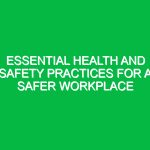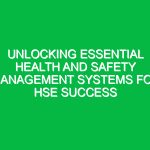Introduction
Hello team! Today, we’re conducting a toolbox talk focused on a critical aspect of our work: the Confined Space Entry Procedures. As you may know, entering confined spaces presents unique challenges and potential Hazards that can have serious consequences if not managed properly. By understanding and adhering to these procedures, we ensure not only our Safety but also the Safety of our colleagues. Let’s dive into the essential elements of confined space entry and the protocols we must follow to protect ourselves and each other.
What is a Confined Space?
A confined space is defined as an area that is not designed for continuous occupancy and has limited means of entry or exit. Examples include tanks, vessels, silos, and pipelines. These spaces can pose significant Hazards, such as low oxygen levels, toxic gases, or physical dangers that can lead to serious accidents or fatalities. Understanding what constitutes a confined space is the first step in recognizing the risks involved.
Understanding the Risks
Before we discuss the Confined Space Entry Procedures, let’s highlight some of the risks associated with confined spaces:
- Asphyxiation: This can occur due to insufficient oxygen levels or the presence of toxic gases.
- Physical Hazards: These include the risk of engulfment, falling objects, or slips and falls.
- Chemical Exposure: Many confined spaces may contain hazardous materials that can pose health risks.
Understanding these risks is crucial as it sets the foundation for the importance of following established procedures. Now, let’s move on to the specific Confined Space Entry Procedures we need to follow.
Key Confined Space Entry Procedures
1. Identify Confined Spaces
The first step in our procedures is to identify all confined spaces within our work area. This involves conducting a thorough risk assessment to ensure that everyone is aware of where these spaces are located. Make sure to look for clear signage and markings indicating restricted access.
2. Obtain Proper Authorization
Before entering a confined space, it’s essential to obtain a permit. This confined space entry permit is a document that confirms all Safety Measures have been taken, including atmospheric testing and equipment readiness. No one should enter a confined space without this authorization.
3. Conduct Atmospheric Testing
One of the most vital steps in the entry procedures is to conduct atmospheric testing. This involves using monitoring equipment to check for:
- Oxygen levels (should be between 19.5% and 23.5%)
- Flammable gases and vapors (should be below 10% of the lower explosive limit)
- Toxic gases (should be within permissible exposure limits)
Always record the results of your tests and ensure they meet safety Standards before proceeding.
4. Ensure Proper Ventilation
Good ventilation can significantly reduce the risk of hazardous atmospheres in confined spaces. Ensure that the area is well-ventilated either naturally or through mechanical means before entry. This may involve using blowers or fans to circulate fresh air.
5. Use Personal Protective Equipment (PPE)
Wearing the right personal protective equipment is crucial for safety. Depending on the hazards present, this may include:
- Respirators for breathing protection
- Gloves to protect your hands
- Hard hats to prevent head injuries
- Safety harnesses if there’s a risk of falling
Make sure to check your equipment before entering and ensure it is in good condition.
6. Establish Communication Procedures
Effective communication can save lives. Establish a communication plan that includes:
- Methods to signal for help in case of emergencies
- Regular check-ins with personnel in the confined space
- Designating a rescue team that is aware of their roles and responsibilities
7. Have a Rescue Plan Ready
Every confined space entry must have a rescue plan in place. This plan should detail how to respond in the event of an emergency. Ensure all personnel are familiar with the plan and that rescue equipment is accessible and in good working order.
Real-Life Scenario: Lessons Learned
Let’s consider a real-life scenario. A team was conducting Maintenance inside a storage tank without following the proper Confined Space Entry Procedures. They failed to test the atmosphere before entry. Unfortunately, they encountered low oxygen levels, leading to one worker losing consciousness. Thankfully, they had a rescue team nearby who was able to perform a quick rescue, but the incident highlighted the critical need for proper procedures.
This situation serves as a reminder of why we must adhere to the guidelines and protocols in place. It’s not just about following rules; it’s about safeguarding our lives and those of our coworkers.
Regulations and Standards
Understanding the Regulations governing confined space entry is essential for compliance and safety. In many regions, regulations such as the Occupational Safety and Health Administration (OSHA) standards outline requirements for confined space entry. Familiarize yourself with these regulations and ensure your work practices align with them. Compliance is not just about avoiding fines; it’s about protecting lives.
Benefits of Following Confined Space Entry Procedures
Implementing and adhering to Confined Space Entry Procedures provides numerous Benefits:
- Increased Safety: Following procedures minimizes risks and protects employees from potential hazards.
- Reduced Liability: Proper protocols can lower the risk of accidents, thus reducing legal liabilities for the company.
- Enhanced Team Morale: A culture of safety fosters a positive work Environment where employees feel valued and protected.
Best Practices for Confined Space Entry
To wrap up, let’s highlight some Best Practices to ensure we maintain a high safety standard:
- Always conduct a pre-entry meeting to review the hazards and procedures.
- Never enter a confined space alone; always have a buddy or team member with you.
- Keep emergency equipment readily available and ensure everyone knows its location.
- Encourage open communication among team members throughout the process.
Conclusion
In conclusion, the Confined Space Entry Procedures are vital to maintaining a safe work environment. By following the guidelines we discussed today, we not only protect ourselves but also create a culture of safety that benefits everyone. Remember, safety is a shared responsibility. Thank you for your attention and commitment to implementing these procedures. Let’s keep each other safe out there!


